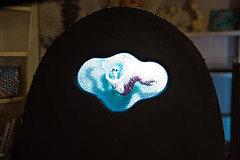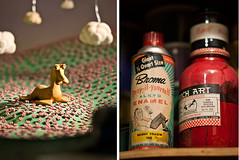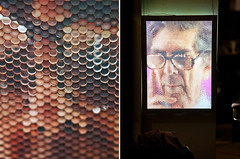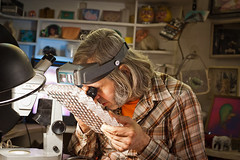Photos: Noah Fecks.
On the northern fringes of Avenue A, an intriguing storefront stands out amidst the taverns, slice joints, and coffee shops. Its façade is blank except for a built-in 1950s-style television that for years has played loops of video art, and its front door is usually open into the wee hours of the morning, offering a view into a cluttered wonderland of doll’s heads, figurines, dioramas, paint tubes, disco balls, 3-D artwork – even a tank of mice.
“What is this place?”, many a bar-crawler has asked.
For twenty years, 202 Avenue A has been the workplace of M. Henry Jones, an artist and animator who, among other things, is on a quest to advance and computerize a form of 3-D photography that was pioneered in the late 1950s but has now fallen mostly out of favor. Next month, he’ll have to vacate the studio, as new tenant has offered to pay nearly four times his rent.
 Noah Fecks A “stereoscopic zoetrope.” The character, called
Noah Fecks A “stereoscopic zoetrope.” The character, calledSnakeMonkey, animates via the use of strobe
lights.
Much like his brand of 3-D photography, the rent that Mr. Jones has paid through the years has been a bit of an anachronism. When he moved into the 640-square-foot space in 1991, it was $750 per month. Today, it’s still just $1,200.
“My landlord has been what I would consider my art patron for many, many years,” Mr. Jones, 53, said on a recent evening, standing outside of his studio in a furry trapper hat that blended into his horn-rimmed glasses and graying mutton-chop sideburns. “He didn’t really lift the rent in keeping with the neighborhood and that was a big asset for me.”
By January 1, however, Mr. Jones’s stroboscopic creations will have been unplugged and the studio’s sagging, overloaded shelves will have been stripped bare. According to his landlord, Paul Gregory, who lives in the building himself, a new tenant has offered to pay somewhere in the neighborhood of $4,500 per month for the ground-floor space, with plans to upgrade it so that it can be used as an audio equipment store. The new occupant (Mr. Gregory could not recall his name, but said he was a “local entrepreneur”) will install a stairway allowing the cellar to be used as a showroom.
Mr. Gregory said that he had little choice but to accept the offer and terminate his month-to-month arrangement with Mr. Jones, since his building was in need of maintenance work. “The magnitude of work that has accumulated over the years has gotten to the point where we can’t afford to not have more rent coming in,” he said, adding that upkeep of the window lintels alone would cost him between $25,000 and $30,000.
“I understood it was going to be painful and hard for Henry, and it wasn’t my intention to make him crazy,” said Mr. Gregory. “It’s just that we couldn’t afford to subsidize his operation anymore.”
Before you go starting a petition: Mr. Jones isn’t leaving the neighborhood. Mr. Gregory, who still considers Mr. Jones a friend, said he had worked to find him a new space. After looking at 25 or 30 options that were unaffordable, Mr. Jones said that he managed to secure a new studio on his own. He’ll pay $1,000 per month for a former storeroom in a co-op building at 412 East 10th Street. It’s one third the size of his current digs, and the rent is considerable for an artist who is currently without representation and is focused on mastering the production quirks of his 3-D work rather than selling it; but it’s manageable, and he’s happy to be getting a deal.
Lucky for Mr. Jones, the new space is a few blocks away from his home on 12th Street between Avenues A and B. (He and his wife, the filmmaker and artist Rachel Amodeo, live in a rent-stabilized apartment that belonged to Richard Edson, an actor and musician who appeared in Ms. Amodeo’s film “What About Me” along with Johnny Thunders, Dee Dee Ramone, Richard Hell, and other iconic East Villagers.)
Nursing a cup of coffee on Avenue A, Mr. Jones said he was delighted that his new space on East 10th Street had a door that opened onto the street – a big part of what made his current studio so special. As he spoke, passersby marveled at a piece that he had dragged out to show on the sidewalk. It was a framed light panel displaying a 3-D rendering of “Molly-Alien,” a cartoonish woman who morphs into an alien as the viewer walks to her left or right.
The piece is an impressive example of integral photography, a method that Mr. Jones helped pioneer in the mid-1980s when he worked under Roget de Montebello, the father of former Metropolitan Museum of Art director Philippe de Montebello. Along with Ronald P. Globus, a trailblazer of panoramic photography, Count de Montebello patented a method in which a sheet of about 2,400 closely packed micro-images (similar in appearance to a Magic Eye image) appear as one large three-dimensional object when viewed through an array of what Mr. Jones called “fly’s-eye” lenses.
Mr. Jones returned to focusing on the technology about five years ago, and currently engineers his own plastic lens sheets, which resemble a flat honeycomb of tightly packed marbles. (If you’re having trouble imagining all this, you can see a portrait he created of his mentor, Count de Montebello, here.) By his estimate, the Molly-Alien cost about $950 to make, not including labor. He hopes to sell it for $7,000.
Inside of the studio, two young interns worked at a computer station, helping with a stereoscopic 3-D short film featuring a rubber figurine named Slatherpuss. (The character originally came to Mr. Jones in a dream and has been featured in his work in various incarnations.) Mr. Jones’s past interns have included Erik Foss, who worked under him after moving to New York City in 1996 and went on to open Fuse Gallery. One of his current interns was a “walk-in,” meaning she walked into the studio off of the street.
Tom Marsan, Mr. Jones’s longtime neighbor and collaborator, said the studio had hosted its share of notable walk-ins over the years. “The guys from the Ramones would come in, or Johnny Thunders, or Rockets Redglare,” he recalled. “You’d see all these unusual artists, everything from people who were professionals in the movie business to homeless guys who’d come in and were just as welcome. The door was open to anyone.”
Stuart Gray, 50, an artist and a musician who performs under the name Stu Spasm, has also worked with Mr. Jones in various capacities over the years. He said of the studio, “You could be in there and Richard Hell would come in, or various New York luminaries who I had only heard of before I moved here. It could be someone totally fascinating, like Jeff Buckley, or it could be somebody that’s a big time-waster.”
Mr. Gray still works with Mr. Jones, but now lives in Greenpoint. He said that he had been priced out of two apartments in the East Village and these days has little reason to go back. “Most of my friends don’t live there anymore,” he said. “I can only think of one or two people that are left.”
Mr. Jones said that he didn’t want to follow Mr. Gray and other casualties of gentrification to Brooklyn, as much as he respected the art scene there. “I’ve been here a little too long,” he said. “I think the East Village is where I belong.”
In fact, Mr. Jones has been a creature of the neighborhood since he took an apartment on East Ninth Street in 1976, a year after arriving from Wilson, a small town north of Buffalo, N.Y., on a full scholarship from the School of Visual Arts. (The college had been impressed with the animated shorts he created in high school, one of which earned him a Kodak Teenage Movie Award).
At S.V.A., he befriended Peter Zaremba, a classmate who formed the garage-punk band the Fleshtones. A few years before the dawn of MTV, they made a sort of music video that paired stroboscopic photo-animation to a Fleshtones performance of “Soul City,” a Hi-Lifes song co-written by Lou Reed.
In 1979, Mr. Jones traveled to Washington D.C. to show an early cut of the film at the “What is Punk Art?” show. He shared a bus with Blondie and the Ramones.
“It was fun,” he said, “because me and Dee Dee [Ramone] and Peter and all of us were looking at the F-15 rocket plane. That was the most important technical achievement when we were kids because it was able to go into outer space. It blew all of our minds.”
“Soul City” played well on the underground circuit: Mr. Jones screened it at Club 57, where he did light shows and installed light sculptures while mingling with Keith Haring, Kenny Scharf, and other fixtures of the scene. Nick Zedd, a leader of the “Cinema of Transgression” movement who for many years painted animation cells for Mr. Jones, screened it alongside his own films as well.
Meanwhile, Mr. Jones had become close friends with the experimental filmmaker Harry Smith, assisting him on paintings and collages, and spending time with him on an almost daily basis.
(Later, for a few months in 1985, he housed Mr. Smith before the then-ailing and elderly filmmaker went on to stay at Allen Ginsberg’s 12th Street apartment, just a block away from Mr. Jones’s studio. After Mr. Smith’s death, Mr. Jones discovered frame filters that were meant to be projected around the screen of the filmmaker’s “Heaven and Earth Magic Feature.” He screened them around the world using multiple projectors and special effects, accompanied by musicians like D.J. Spooky and Daniel Johnston. Footage from a Sept. 2006 screening at Angel Orensanz can be seen on YouTube.)
Around 1983, Mr. Jones established SnakeMonkey. His studio created animation for Doug E. Fresh’s “All the Way to Heaven” video as well as a series of advertisements for America’s Best Contacts and Eyeglasses that achieved some notoriety among art school students.
“Every time I made a T.V. commercial,” he said, “I tried to make it better, or more far out or more involved or more psychedelic.”
At the same time, the animator had a deep nostalgic streak. Mr. Gray described Mr. Jones as a “mad scientist,” but also said, “He was very anti-computers, so he made commercials that had kind of a Disney-studio thing going on, at a very cut rate.” (Mr. Jones has since warmed to computers and – with the assistance of Keith Lubell, a former longtime East Villager – is using them extensively to refine his fly’s-eye photography, and to convert two-dimensional photographs into 3-D.)
Mr. Marsan, who co-directed the commercials, said, “Henry was a big fan of things in the past. Even when he’s working on his 3-D stuff, he’s using an old technology. 3-D is more popular than ever – almost every movie that comes out for kids is 3-D, and it’s a leading-edge thing, but he’s into this old technology. He’s going back in time to go into the future, if that makes sense.”
While making commercials from 1986 to 1995, Mr. Jones employed as many as 14 artists at a time – many of them his neighbors in the East Village.
Mr. Marsan said that the process was very much collaborative: “Henry has great ideas but he can’t draw his own name. He can’t draw at all.”
Still, his time with Mr. Jones taught him a great deal. “I learned everything about animation from Henry,” he said. “Working in a small studio was ideal because you had to learn and do everything – reading sheets, loading the camera, pegging stuff, drawing, background; I learned all of it.” Mr. Marsan went on to work in Korea as art director of MTV’s animated show “Daria,” and now freelances in addition to working as a layout artist on the Adult Swim show “Superjail!”
Mr. Jones said there was a downside to running an around-the-clock animation company out of his East Ninth Street apartment. In 1991 he was forced to move to 202 Avenue A because, he said, his employees were bothering the neighbors by ordering Chinese food at all hours of the night.
“There were always four stations set up here where people would be working,” he said of his Avenue A set-up. “Someone would be working on the drawings; someone would be painting the cells; someone would be on the animation stand in the back, shooting tests.”
The animation stand was created for him by his friend Bob Franz, an animator of the pre-computerized Pillsbury Doughboy as well as other iconic commercials. It has now been placed in storage ahead of the move next month.
Mr. Jones said that he planned to launch a Kickstarter campaign in January, in an effort to fund the move to East 10th Street and to support his advancements in fly’s-eye photography. He is convinced he can continue to build a name for himself with the technology, even if his peers have mostly abandoned it.
“The work I’m doing is extremely cutting-edge,” said Mr. Jones. “It’s the type of work that would possibly be done at Bell Labs or something like that, except that Bell Labs [Holmdel Complex] is closed and is lying out there in New Jersey rotting away while I’m over here in the East Village doing really high-caliber work because a lot of the industry has gone away.”
A lot of the hip factor, he said, had also gone away from the East Village. “I don’t really understand what happened to the culture,” he said. “It used to be there were a lot of buildings around here where people had art studios or stores that would sell artwork – not commodified stuff, but stuff that was unique and was made around here. It’s really sad – I used to sit right here at my desk over the years, and there was a period of time when people would come pouring out of the L train to come through here. They were living in Brooklyn at the time, but I guess they got tired of traveling to Manhattan because now you don’t see them.”
“The changes are not good,” he continued, “but I think that when you run away from change it just follows you. It’s sad the neighborhood has changed as much as it has but there’s a lot of people that are still holding on here and I enjoy it.”
Mr. Marsan, who is one of those people holding on, said, “In the 80s everybody wanted to be a writer or a musician or a painter, involved in the arts. Now it’s a lot more restaurants and coffee shops and fancy dresses and pocketbooks. The neighborhood has definitely changed. A lot of the old trends have gone and moved on. I ran into [the artist] James Romberger in the Key Foods supermarket. You’re always happy to see one of the originals – people who’ve been here 25 years. Those people are few and far between.”
That said, Mr. Jones still gets his share of interesting walk-ins. About a year ago, Steve Holmgren, a programmer at UnionDocs, stopped into the studio out of curiosity, on his way to a meeting. After eventually seeing Mr. Jones’s work at a Howl! event, he was so impressed by it that he ended up producing a retrospective of it at Anthology Film Archives last March.
And so, art isn’t entirely dead in the East Village: In fact, a gallery space will open up right next door to Mr. Jones’s old studio, in the former Superdive space. Currently, it’s sorting out its liquor license.








